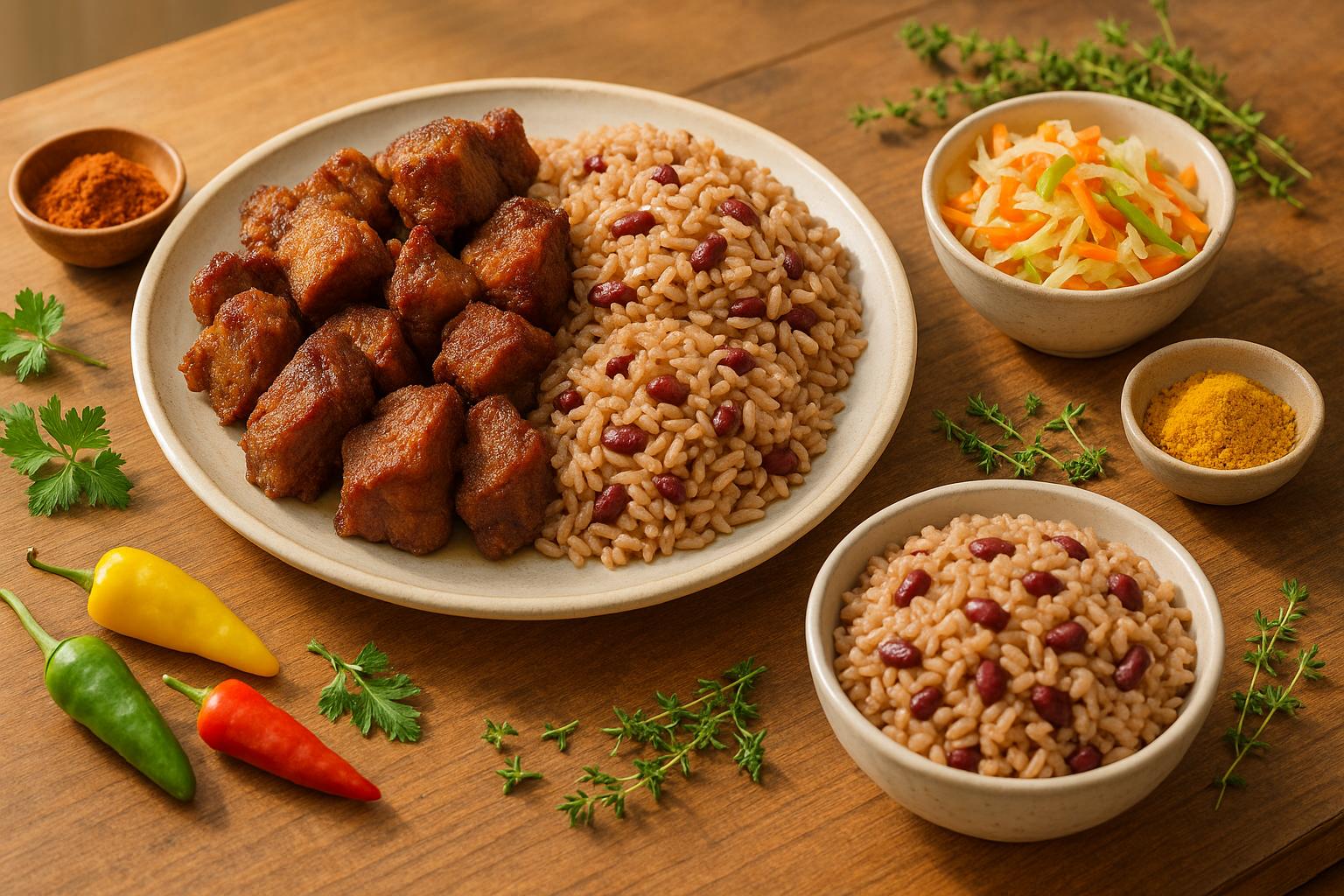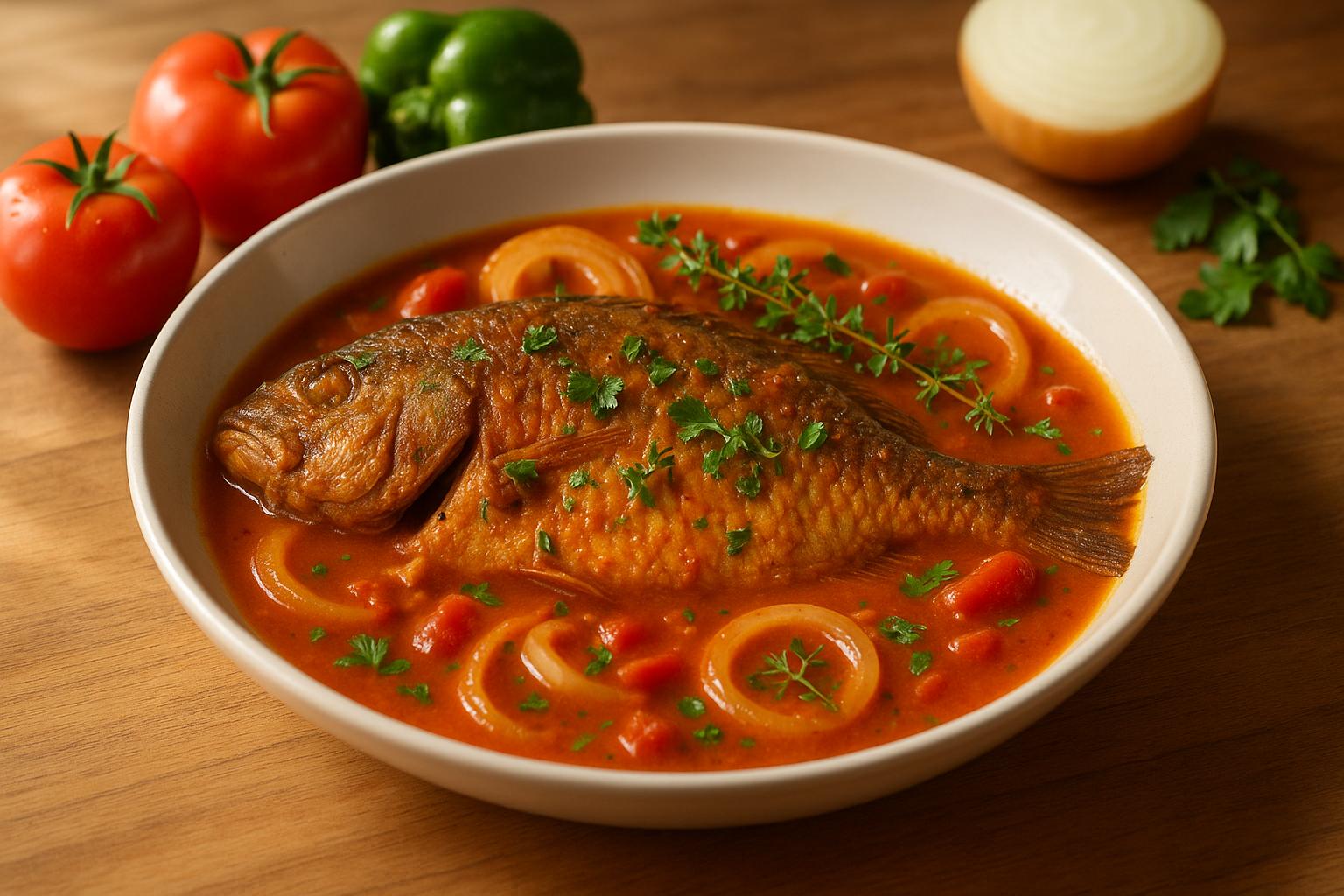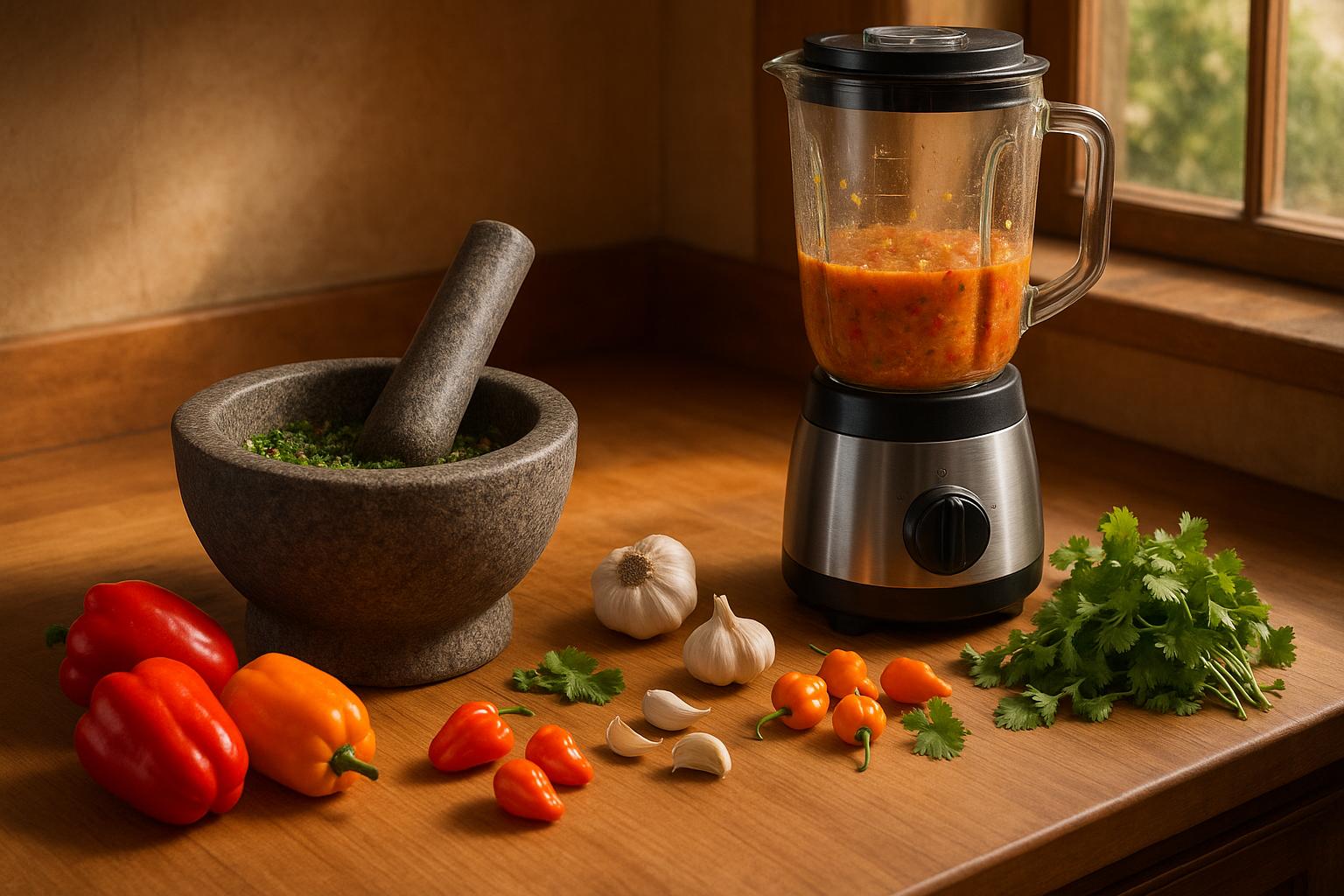Haitian seafood traditions are a blend of history, geography, and resourcefulness. With its long coastline, Haiti offers a variety of seafood dishes that showcase flavors influenced by African, Taíno, French, and Spanish practices. Celebratory meals like Lambi an Sos (conch in sauce) and Pwason Gwo Sèl (salt-marinated fish) highlight this rich heritage. However, economic factors often make seafood a luxury for many.
Key points include:
- Historical Roots: Taíno fishing techniques, French cooking methods, and African spices shaped Haitian seafood cuisine.
- Cooking Techniques: Marinating, stewing, grilling, and frying are common, with bold seasonings like epis (herb-spice blend) at the core.
- Regional Specialties: Coastal areas like the Sud department focus on conch and fish, while the Grand’Anse region features dishes like tonmtonm (mashed breadfruit with okra sauce).
- Diaspora Influence: Haitian communities in the U.S. preserve these dishes by adjusting recipes to local ingredients, ensuring the flavors endure.
Haitian seafood tells a story of resilience, blending local resources with centuries-old traditions to create vibrant, flavorful dishes. Whether in Haiti or abroad, these recipes connect people to their roots and history.
History and Meaning of Haitian Seafood
Early Island Seafood Practices
Long before European ships ventured into the Caribbean, the Taíno people had already mastered the art of fishing. Living in harmony with the ocean, they developed techniques like using hooks, basket traps, nets, and weirs to sustain their daily needs. Spanish colonizers documented over 60 Taíno names for various fishes, sharks, and marine mammals - a testament to their deep connection with the sea and its resources[4]. Archaeological findings reveal their diet included grunts, parrotfishes, groupers, snappers, and jacks - species still enjoyed in Haitian cuisine today[4].
The Taíno didn’t stop at catching seafood; they also excelled in preserving it. They grilled, smoked, salted, and stewed fish, often combining it with chili and vegetables in "pepper pots." At the Coralie site on Grand Turk, evidence of meals cooked in an overturned sea turtle shell was discovered, featuring fish and iguana[4]. Conch, or lambi, was another essential resource. Salt River became a key harvesting site, and the Taíno developed methods to extract and salt-cure conch for preservation[3].
European and African Cooking Methods
The arrival of French colonizers in the 17th century brought new influences to Haitian seafood preparation. French cooking techniques and seasonings merged with indigenous practices, creating a rich culinary fusion. Enslaved Africans added even more depth to Haitian cuisine by introducing ingredients like okra, pigeon peas, taro, ackee, and a variety of spices[1]. Together, these contributions helped shape the bold, layered flavors that define Haitian cooking today.
"Haitian cuisine is a flavorful and vibrant reflection of the country's rich history and cultural heritage. Its origins can be traced back to a blend of African, French, indigenous Taíno, and Spanish culinary traditions." – Haitian Food Network[5]
This blending of traditions gave rise to Creole cuisine, a hallmark of Haitian identity. After the Haitian Revolution, many people - both white settlers and formerly enslaved individuals - migrated to Louisiana, bringing with them dishes like red beans and rice and other Creole-inspired recipes[1]. This shared culinary heritage continues to influence both Haitian and Louisiana cooking.
Historic Seafood Dishes
Among Haiti's iconic seafood dishes, lambi (conch) holds a special place. It’s more than just a meal; it’s a symbol of Haiti’s resilience and fight for freedom. Dishes like Lambi an sos - a slow-cooked, spiced conch preparation - pay homage to this legacy.
Other seafood traditions also carry historical weight. Techniques like grilling and smoking fish link modern Haitian cooking to its Taíno roots, while the use of intricate spice blends in stews reflects the enduring influence of African culinary practices.
Despite Haiti’s extensive coastline, seafood has historically been a luxury. Economic challenges meant fish consumption was limited, with per capita consumption at just 1.18 kg per year in 1976. By 1980, imported cured fish cost between $2 and $4 per kilogram, making it a celebratory dish rather than an everyday staple[6].
"Haitian food culture is an expression of identity, resilience, and community. It is the way we honor our history, celebrate life, and connect with each other. It's not just about food - it's about storytelling, pride, and preserving a legacy that blends African, Indigenous, French, and Caribbean influences." – Nadege Fleurimond[2]
These seafood dishes serve as a bridge between the past and present, keeping Haiti’s culinary heritage alive in every bite.
Popular Haitian Seafood Dishes and Cooking Methods
Main Dishes and Key Ingredients
Lambi, or conch, is often considered the highlight of Haitian seafood cuisine. This delicacy is a staple at weddings, holidays, and other festive occasions, making it a centerpiece of Haitian culinary celebrations [7]. Alongside lambi, other iconic dishes showcase the country’s rich seafood traditions.
One standout is Pwason Gwo Sèl (literally "Fish Big Salt"). Despite its name, this dish isn’t overly salty but refers to a traditional preparation method. Fish like red snapper or cod is marinated with coarse sea salt, lime juice, sour orange juice, white vinegar, and epis - Haiti’s signature green seasoning blend. This dish holds special significance, especially during Good Friday celebrations, as highlighted by The Haitian Times in April 2025 [9].
Another beloved dish is Marinad, savory fried dough balls often served alongside seafood. The flavor of epis - a mix of peppers, garlic, and herbs - shines in this preparation, tying it to the heart of Haitian seasoning traditions [1].
Haitian Cooking Techniques
Haitian seafood dishes are deeply rooted in traditional cooking techniques that bring out bold and layered flavors. These methods reflect the country’s regional and seasonal diversity.
Marinating is an essential first step in Haitian seafood preparation. Fish is typically soaked in a mixture of lime juice, epis, and spices for at least an hour. This process allows the marinade to infuse the fish with vibrant flavors before cooking [9].
Stewing is another cornerstone technique. Marinated fish is lightly seared and then simmered in a sauce made with onions, bell peppers, garlic, tomato paste, epis, and either water or fish stock. The result? Tender fish enveloped in a richly flavored sauce [9].
Grilling adds a smoky depth to Haitian spices, while frying creates crispy textures often paired with pikliz - a spicy, vinegar-based slaw made with cabbage, carrots, and Scotch bonnet peppers. This combination balances heat, acidity, and crunch, creating a complex flavor profile [1].
The liberal use of peppers and herbs in these methods reflects Haiti’s culinary influences, blending bold flavors into every dish [1].
Regional and Seasonal Differences
Haiti’s seafood traditions vary by region, shaped by local resources and cultural preferences. Coastal areas, in particular, showcase unique specialties.
In the Sud department, conch and a variety of fish dominate menus due to the region’s coastal access. The Sud-Est department is especially known for its flavorful takes on Pwason Gwo Sèl [1].
The Grand’Anse department, particularly around Jérémie, features distinctive dishes like tonmtonm. This dish combines steamed mashed breadfruit with a slippery okra sauce cooked with meat, fish, or crab, along with savory spices. Its resemblance to West African fufu highlights the blending of African culinary traditions with Haitian ingredients [1].
In the northern regions, such as Cap-Haïtien, local seafood dishes reflect access to different fish species and unique cultural tastes. Seasonal factors also play a role in shaping what’s on the table. During peak fishing seasons, fresh catches like red snapper are abundant. In contrast, preserved and salted fish become staples during harsher weather, showcasing the adaptability of coastal communities to the rhythms of nature.
Haitian Seafood Today and in Diaspora Communities
Keeping Seafood Practices Alive Abroad
Haiti's deep maritime heritage and traditional cooking methods have found new life in diaspora communities across the United States. Haitian immigrants, particularly in cities like Boston, New York, and Miami, have found ways to preserve their culinary roots while adapting to their new surroundings. These adjustments reflect both resourcefulness and a strong connection to the flavors of home [10].
Traditional recipes often undergo creative tweaks to accommodate the availability of ingredients in the U.S. Chef Nadege Fleurimond sheds light on this process:
"Recent Haitian immigrants come to the U.S., adapt and reframe our cuisine to fit the available ingredients, the various diet fads or trends. Haiti Uncovered is about presenting the real essence of the food, and how it's cooked in the motherland. As a culinary professional, part of my job is to change food. I take something old, I make something new out of it. Our job as chefs and food professionals is to stretch our clients' palates and minds in terms of food." [11][12]
For instance, when scotch bonnet peppers are hard to find, habaneros step in to deliver a similar punch of heat and fruity undertones. Djon djon mushrooms, a staple in many Haitian seafood dishes, are creatively substituted with a mix of dried porcini mushrooms and squid ink to replicate their earthy taste and signature dark hue [8]. These substitutions and adaptations ensure that the essence of Haitian cuisine remains intact, even far from home.
In some Haitian-owned establishments, customers are encouraged to place orders in Haitian Creole, reinforcing a sense of cultural authenticity. This adaptability has made it possible to discover Haitian seafood dishes in U.S. markets, keeping these cherished traditions alive [10].
Finding Haitian Seafood in U.S. Markets
Despite challenges, authentic Haitian seafood is becoming more accessible in the United States. Dishes like Lanbi an Sòs (conch in Creole sauce) and Pwason Boukannen (grilled fish) are now staples in Haitian restaurants across major cities [14].
Caribbean markets and specialty grocery stores are key for sourcing authentic ingredients, such as djon djon mushrooms. For those without access to these stores, online retailers have stepped in, offering nationwide delivery of essential Haitian ingredients, making it easier to recreate traditional dishes at home [16].
One standout example of Haitian cuisine in the U.S. is Naomi's Garden in Miami, which has gained recognition for its authentic offerings. The restaurant serves dishes like fried grouper paired with pikliz, a tangy and spicy pickled mix of cabbage, carrots, bell peppers, and scotch bonnet peppers. This vibrant condiment perfectly complements the rich flavors of seafood [15].
The importance of these culinary connections goes beyond taste. Stephan Berrouet Durand, founder of the Haitian Culinary Alliance, emphasizes the deeper meaning behind sharing food:
"If you really want to teach someone anything about your culture, food is a driver for that." [10]
In this way, enjoying Haitian seafood in the U.S. becomes more than just a meal - it’s a way to preserve cultural identity and pass cherished traditions to younger generations.
Using HaitianFoods.org to Find Seafood

For those eager to explore authentic Haitian seafood, HaitianFoods.org offers a comprehensive resource. The platform connects users to restaurants specializing in traditional Haitian dishes, particularly in areas with large Haitian populations like Miami and Fort Lauderdale.
Highlighted restaurants include St. Hilaire Family Restaurant, known for its Seafood Bouillon, and Chef Creole Seasoned Restaurant, which combines Caribbean flavors with Creole influences. Other notable spots include Good Times Cuisine, famous for its Conch Creole, and Naomi's Garden Restaurant & Lounge, a beloved Haitian-Caribbean establishment in Liberty City [17].
The directory also extends beyond Miami, featuring restaurants like Cecibon Restaurant, which operates in both Miami and Fort Lauderdale, and Le Jardin Haitian Restaurant in Miami's Little River neighborhood. North Miami's Lakay Food Spot ensures that authentic Haitian flavors are accessible throughout South Florida [17].
Beyond restaurant listings, HaitianFoods.org offers a blog filled with cultural insights, helping users deepen their understanding of Haiti's rich culinary traditions. This platform serves as both a guide and a tool for preserving Haiti's vibrant food culture.
Chef Alain Lemaire captures the essence of Haitian cuisine and its cultural significance:
"Haitian food is very rich, flavorful; it's bold, fresh and in your face. It is the heart of what we represent because food for us is not only about nutrition, but it brings everybody together. Every celebration involves food. It's about unity and strength." [13]
sbb-itb-80c33ff
Keeping Haitian Seafood Practices Alive
Main Points
Haitian seafood traditions are more than just recipes - they're a testament to centuries of resilience and cultural identity. These culinary practices weave together African, French, Spanish, and indigenous Taíno influences, creating a vibrant tapestry of flavors and history. As Sam Oriach explains:
"Haitian food is more than just a meal. It's a living history." [18]
Take soup joumou, for instance. This dish symbolizes freedom and unity, much like many other Haitian recipes that evoke a deep sense of community and pride. For Haitians living abroad, these traditions act as a bridge to their homeland. Ingredients like the cherished djon djon mushrooms are often brought back from Haiti as heartfelt gifts, highlighting their profound connection to cultural roots. [18]
Haitian cooking revolves around fresh, local ingredients and bold, vibrant flavors. A key element is epis, a flavorful green paste made from fresh herbs and aromatics that serves as the backbone of many dishes. Haitian cuisine is gaining recognition on a global scale - TasteAtlas recently ranked it 67th in its 2024 list of the world's 100 best cuisines. [19]
These traditions not only tell a story but also offer a roadmap for preserving and celebrating Haiti’s culinary heritage.
Next Steps
To truly embrace Haitian seafood traditions, start by sourcing authentic ingredients. Caribbean markets and specialty grocers are great places to find staples like djon djon mushrooms, scotch bonnet peppers, and the essentials for making epis. If certain ingredients are hard to come by, you can get creative - combine lime and orange juice as a substitute for sour orange, or mix dried porcini mushrooms with squid ink to replicate the earthy flavor of djon djon. [18]
Once you’ve gathered the ingredients, dive into the rich stories and recipes that define Haitian cuisine. Haitian cookbooks are an excellent resource for learning authentic dishes while understanding their cultural significance. These efforts not only keep traditions alive but also inspire creativity within Haitian cooking.
Above all, support the people and communities preserving these culinary practices. Explore HaitianFoods.org to find authentic Haitian restaurants near you, from popular spots in Miami to hidden gems in diaspora communities across the U.S.
Making Traditional Mayi Moulin & Red Snapper Stew in Dallas! 🥘 Discover Haitian Flavors
FAQs
How do Haitian communities in the U.S. adapt traditional seafood recipes when certain ingredients aren't available?
Haitian communities across the U.S. have found creative ways to keep their traditional seafood dishes alive by working with locally available ingredients that closely mimic the flavors of those from Haiti. Take habanero peppers, for example - they often step in for Scotch bonnet peppers, offering a similar fiery kick and fruity notes. When it comes to seafood, options like red snapper, tilapia, or shrimp are popular stand-ins for the fish varieties native to Haitian waters.
By combining traditional cooking methods with accessible local ingredients, Haitian-Americans maintain the heart and soul of their culinary traditions. This thoughtful blending ensures the flavors of Haiti continue to thrive, even thousands of miles from the island.
What are some traditional Haitian seafood dishes that highlight the country’s cultural heritage?
Haitian cuisine offers a variety of seafood dishes that carry deep ties to the nation’s heritage and traditions. One iconic dish is pwason gwo sèl (salted fish), which holds special meaning during Good Friday, representing both faith and resilience. Beyond that, you’ll find rich seafood stews and vibrant fresh fish salads, often served at social events and celebrations. These dishes not only showcase Haiti’s culinary creativity but also highlight the resourcefulness and strong community bonds that are central to its culture.
What historical influences have shaped Haitian seafood cuisine and its flavors?
Haitian Seafood Cuisine: A Fusion of Flavors
Haitian seafood cuisine is a rich tapestry woven from a mix of African, French, Spanish, and indigenous Taíno influences. Each of these cultural roots has added its own flair, creating a cuisine that’s bold, aromatic, and packed with flavor.
The African diaspora introduced vibrant seasonings and cooking methods that remain essential to Haitian dishes. French and Spanish colonization brought European techniques and ingredients, further enriching the culinary landscape. Meanwhile, the Taíno people contributed their deep knowledge of local seafood and resourceful cooking practices, such as grilling and slow cooking. Together, these elements form a culinary tradition that highlights the beauty of fresh seafood, enhanced with bold marinades and spices.


